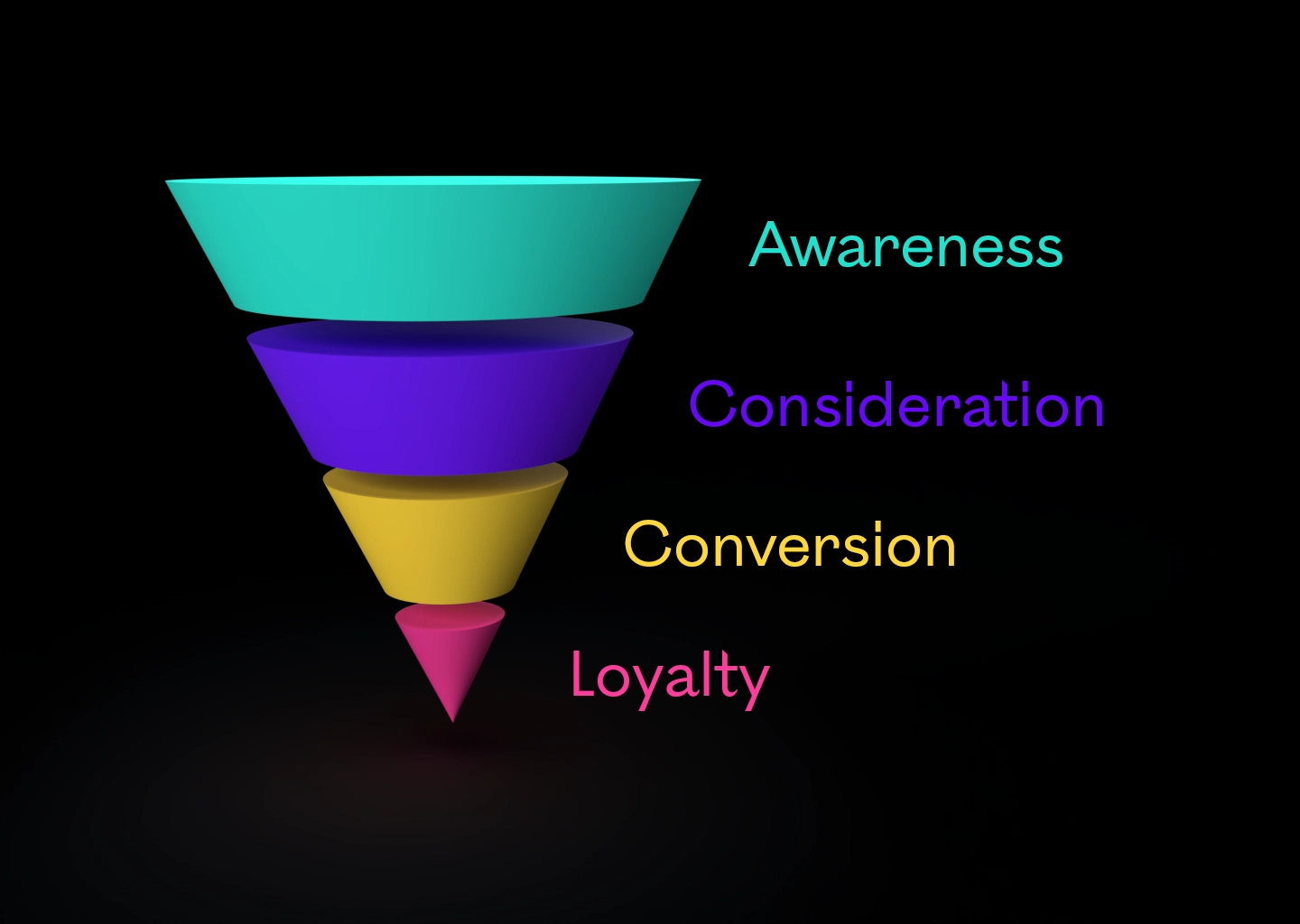We care about your data, and we'd love to use cookies to make your experience better.
How to Convert More Customers Using a Full-Funnel Media Strategy
A customer's journey to conversion is not a linear one; there are starts and stops, jumps and turns, as they navigate various platforms and competitive messages. With all of this noise and misdirection, how can a brand develop their customer base effectively and efficiently?
Whether you’re a small local business or a large multinational corporation, a well developed and carefully curated full-funnel media strategy is key to your customer acquisition success.
The Customer Journey
When we talk about the marketing funnel, what we’re really describing are the steps within the customer’s path to purchase. Ie. How someone goes from being completely unaware of your brand to becoming an ambassador of it. At a very high level, those steps typically fall within these layers:
- Awareness: At this stage, people don’t know about your brand, and potentially aren’t even aware of the problem that your product/service can help solve for them.
Goal – Introduce your brand, capture their attention and gather data if possible. - Consideration / Education: This group is actively searching for a solution to their problem and are weighing their options.
Goal – Provide more information about why your product or service is the solution to their problem. Engage with and nurture leads to build trust. - Conversion: These are your low-hanging fruit. They are ready to make a decision.
Goal – Make it easy for them to convert! Ensure you have a clear and simple CTA.
- Loyalty: They’ve completed a purchase!
Goal – Provide a great ongoing experience to convert them into repeat customers and brand advocates.

Every Layer Matters
When companies bypass the awareness and consideration phases within their marketing funnel and focus their media planning and budget entirely on conversion tactics, they’re missing out on some key opportunities to grow their business. This type of strategy places all (or most of) their advertising spend into pay-per-click (PPC) campaigns in an effort to speak exclusively to the highest intent audience, lowest in the purchase funnel. While this does provide instant gratification by attributing your dollars directly to the conversions they produce, it is not a recipe that can be sustained indefinitely. This strategy does not continually build demand and bring new customers into the funnel – so, once you’ve serviced all of your current customers and those ready to buy, you will have emptied your lead funnel entirely.
By foregoing all brand awareness tactics, you’ll eventually begin to pay more and more for your leads, defeating the entire purpose of only investing in conversion layer tactics in the first place. You’ll also eventually see increased customer lifecycle acquisition costs (the cost to keep this customer as a repeat customer). Google commissioned a recent Nielsen meta-analysis of consumer packaged goods (CPG) campaigns, which found that full-funnel strategies see up to 45% higher ROI and 7% increases in offline sales compared to marketing campaigns across a single purchase stage. Bottom line, your ad spend will produce stronger results in the long run if you focus on building a full-funnel media strategy, including channels in every funnel layer.
Learn From Your Upper Funnel
Along with attracting a larger number of people to add to your marketing funnel, brand awareness tactics can help to lend credibility and legitimacy to your brand. In fact, a survey found that the top five most trusted advertising formats are all traditional “brand awareness” level tactics. Customers reported trusting print advertising (82%), television advertising (80%), direct mail advertising (76%), and radio advertising (71%) to make purchasing decisions. Increasing your brand presence and instilling that level of trust will provide consumers with the confidence required to choose your product or service once they are ready to make a purchase decision.
Another benefit of awareness level tactics is that they can provide you with additional audience insights. Is your creative and message resonating with your target audience? Do you need to alter the demographic you’re targeting? When is the best time to retarget with additional ads? The insights you gain allow you to create, refine, or alter your mid-funnel retargeting strategies.
We prefer to think of the mid-funnel consideration layer as the ‘education’ phase. This is where it is crucial to provide enough information to differentiate your brand from the competition. The insights you gain from your awareness ads help to create a more personalized journey for your customer – showing them the right ad, with the right information, in the right place, at the right time. This efficiency increases your return on ad spend (ROAS), and the likelihood of the customer converting.
Creating a Connected Strategy
So, what does a full-funnel media strategy actually look like? The answer – it depends. Many factors including your industry, your audience, and your campaign goals will impact where to focus your efforts. This makes upfront research, strategy and planning especially important. After all, if you don’t know who you’re trying to reach, and why, then how will you establish the best way to reach them? At Flipp, we use a mix of primary and secondary research to put together a solid situation analysis and to form our recommendations for media channels, placements, timing, and creative considerations.
Speaking of creative considerations – while creating a connected strategy, understand that your media strategy is only as effective as the campaign’s creative and messaging. There are many factors to consider when tying your campaign creative into your media plan. When we’re at the top of the marketing funnel, we want to keep the creative and messaging more brand-focused. As we move down the funnel, we can get more tactical, including key decision-based information like price points. As an example, If you’re selling homes, the top of the funnel is where you’d focus on emotive messaging and storytelling to captivate your audience, such as “Home is where the heart is”. Then, very low in the funnel is where you can assume they’ve heard of your brand, are interested in what you’re selling, and want info that will help influence their final decision, such as “Prices starting in the low $400’s. Visit our new showhome.”
Above all, it’s very important to integrate your media strategy with your creative campaign. When working on advertising campaigns, creative can influence the media strategy, and media informs creative about what will resonate the most with the target audience.
A Healthy Funnel is a Full Funnel
Keeping a holistic, full-funnel media strategy in mind will allow you to build a solid and sustainable foundation for your brand. Rather than focusing all of your efforts on trying to get everyone to immediately convert into a customer, a full-funnel strategy introduces your brand to new potential customers, educates them about your offering, tells them how to take action, and provides them with enough value to ensure their return.
Let Flipp ensure your media strategies can stand the test of time. Flipp us an email to start the conversation.
